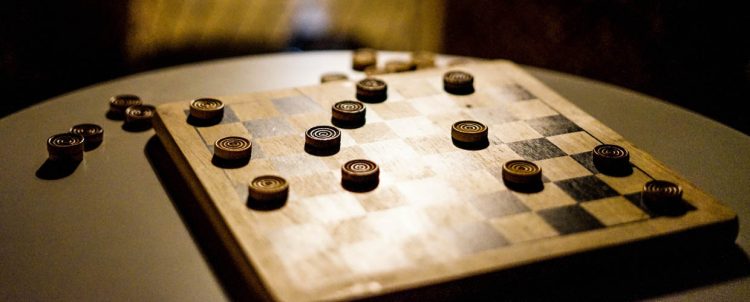: Mastering the Art of Checkers: Unraveling the Intricacies of the Game’s Rules

Checkers, a classic board game that has captivated minds for centuries, is a strategic two-player contest that combines simplicity with depth. The game’s origins can be traced back to ancient civilizations, and it has evolved into a timeless pastime enjoyed by people of all ages. To truly master checkers, one must understand its rules, which form the checkers rules foundation for every move and decision made on the checkered battlefield.
Basic Setup:
Checkers is played on an 8×8 square board, with each player positioned on the dark squares of their side. Each player starts with 12 pieces, usually distinguished by color – red and black are common choices. The pieces are initially placed on the dark squares of the three rows closest to them.
Movement Rules:
The rules governing the movement of checkers pieces are straightforward but crucial. Players take turns moving their pieces diagonally forward along the dark squares. However, there’s a catch – each move is restricted to an adjacent, unoccupied dark square. In essence, checkers is a game of calculated advancement, as players strategically navigate their pieces across the board.
Capturing Opponent’s Pieces:
Checkers gains its strategic depth from the ability to capture an opponent’s pieces. This is achieved by jumping over an enemy piece diagonally if the square beyond it is vacant. The captured piece is then removed from the board, symbolizing the ruthless nature of the game. If a player has multiple capturing options, they can choose the most advantageous path, initiating a series of consecutive jumps known as a “double jump” or “multiple capture.”
Kinging:
The pinnacle of a piece’s journey in checkers is achieving the status of a “king.” A king is created when a piece successfully reaches the last row on the opponent’s side of the board. This promotion is denoted by placing an additional piece on top of the original, signifying its enhanced capabilities. A king is not only a symbol of prestige but also a strategic asset, as it gains the ability to move both forward and backward diagonally.
Forfeit Rules:
In checkers, forfeiting a move is not an option, as players are required to make a move whenever possible. If a player fails to do so, their opponent has the right to claim a victory. This rule ensures an active and engaging game, where strategic planning and quick thinking are paramount.
Endgame Scenarios:
As the game progresses, players strategically maneuver their pieces, aiming to outwit their opponents. The endgame often involves careful consideration of piece placement and movement, with players vying for control of the board. The game concludes when one player captures all the opponent’s pieces or blocks their ability to make a legal move. The victorious player revels in the satisfaction of a well-executed strategy, while the defeated player reflects on the moves that led to their downfall.
Strategic Considerations:
Checkers is not merely a game of chance; it is a battleground of wits and strategy. Players must balance offense and defense, considering both short-term gains and long-term positioning. Centralizing control of the board and creating opportunities for multiple captures are key tactics. A successful player must also be adept at anticipating their opponent’s moves and adapting their strategy accordingly.
Etiquette and Sportsmanship:
Beyond the rules of the game, checkers has an unspoken code of etiquette and sportsmanship. Players are expected to conduct themselves with respect and fairness, maintaining the spirit of friendly competition. A gracious winner acknowledges their opponent’s efforts, and a graceful loser accepts defeat with dignity. These unwritten rules contribute to the enduring appeal of checkers, fostering a sense of camaraderie even in the heat of competition.
Variations and Regional Rules:
While the basic rules of checkers are universal, variations and regional adaptations exist, adding nuance and diversity to the game. Some regions incorporate specific rules regarding forced captures, draw conditions, or the use of timers to regulate gameplay. Exploring these variations can deepen one’s appreciation for the game, providing new challenges and perspectives.
Conclusion:
In the world of board games, checkers stands as a timeless masterpiece, captivating players with its blend of simplicity and strategic depth. By mastering the intricacies of the game’s rules, players unlock the door to a world of strategic possibilities. From the initial setup to the intense endgame, checkers offers a rich tapestry of challenges and triumphs, making it a cherished pastime for generations past, present, and future. So, the next time you engage in a game of checkers, remember that each move is a step toward victory, and the rules are the guiding principles that make the journey both thrilling and rewarding.
-
How is the checkers board set up?
- The checkers board consists of 64 squares arranged in an 8×8 grid. Players position their pieces on the dark squares of the three rows closest to them.
-
How do checkers pieces move?
- Checkers pieces move diagonally forward along the dark squares. Each move is restricted to an adjacent, unoccupied dark square.
-
Can checkers pieces move backward?
- Regular checkers pieces can only move forward. However, once a piece reaches the last row on the opponent’s side, it is “kinged” and gains the ability to move both forward and backward diagonally.
-
What is “kinging” in checkers?
- “Kinging” is the process by which a regular checkers piece becomes a king. It occurs when a piece reaches the last row on the opponent’s side of the board. A king can move both forward and backward diagonally.
-
How do you capture opponent’s pieces in checkers?
- To capture an opponent’s piece, jump over it diagonally if the square beyond it is vacant. Captured pieces are removed from the board. Players can perform multiple captures in a single turn, known as a “double jump” or “multiple capture.”
-
Can a player forfeit a move in checkers?
- No, players are not allowed to forfeit a move. If a player fails to make a move when possible, their opponent has the right to claim a victory.
-
When does the game end?
- The game ends when one player captures all the opponent’s pieces or blocks their ability to make a legal move. The player with remaining pieces or strategic advantage is declared the winner.
-
What happens in a draw or stalemate situation?
- In checkers, if a position repeats three times with the same player to move, or if 25 consecutive moves are made without any captures or kinging, the game is declared a draw.
-
Are there different variations of checkers rules?
- Yes, there are variations and regional rules that add nuance to the game. These may include specific rules regarding forced captures, draw conditions, or the use of timers to regulate gameplay.
-
Is there a code of etiquette in checkers?
- Yes, checkers has an unspoken code of etiquette and sportsmanship. Players are expected to conduct themselves with respect and fairness, acknowledging their opponent’s efforts and accepting both victory and defeat with dignity.
-
Can kings be captured in checkers?
- Yes, kings can be captured in the same way as regular pieces—by jumping over them diagonally. However, kings have the advantage of being able to move backward, making them more versatile and strategic.
-
Can I promote more than one piece to a king in a single turn?
- No, only one piece can be promoted to a king in a single turn. Once a piece reaches the last row on the opponent’s side, it is immediately crowned a king.
-
Are there online platforms to play checkers?
- Yes, numerous online platforms and mobile apps offer opportunities to play checkers against opponents from around the world. These platforms often follow standard checkers rules but may also include variations and customizations.
-
How do I improve my checkers strategy?
- Improving checkers strategy involves a combination of studying common tactics, analyzing previous games, and gaining experience. Practicing against opponents of varying skill levels can also contribute to honing strategic skills in checkers.





